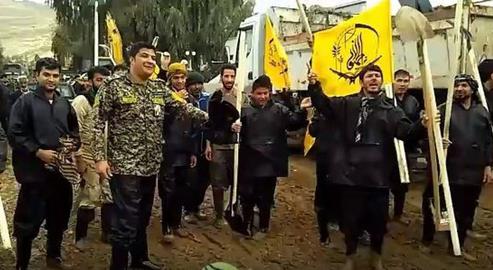“If we do not help the Revolution, then the Iraqi Popular Mobilization Forces, Afghani Fatemiyoun, the Pakistani Zeinabyoun and the Yemeni Houthis will come to help the Revolution.”
On March 6 when the media published this statement by Musa Ghazanfar-Abadi, head of Tehran’s Revolutionary Courts, nobody imagined that in less than two months the militiamen of the Iraqi Popular Mobilization Forces would arrive in Iran, armed and traveling in military vehicles.
On Saturday, April 14, Colonel Jamal Shakarami, commander of the Islamic Revolutionary Guards Corps (IRGC) in the western province of Ilam, said that a large convoy of Iraqi militiamen had arrived in Iran to help provide aid and relief to areas hit by recent floods. Shakarami said a convoy of 50 vehicles carried Iraqi Al-Nojaba and Hashd al-Sha'bi militias into Iran's western provinces – among some of the worst-hit regions. Some units were to be stationed in Khuzestan and others to act as mobile units in Khuzestan and Lorestan to help flood victims. On Saturday, Iraj Masjedi, Iran’s ambassador to Baghdad, confirmed to Iranian news agencies that hundreds of Iraqi militiamen had been deployed to western Iran.
All of the Iraqi militia groups also happen to be forces that were either created by the IRGC or have close relations with it and share its ideology.
“A convoy from the Iraqi Al-Nojaba [militia], consisting of more than 100 light and heavy vehicles, has entered Iran at the Mehran border,” reported Fars News Agency, which itself is affiliated with the Revolutionary Guards. Fars added that Al-Nojaba is equipped with loaders, graders and other road-making equipment.
The Hashd al-Sha'bi militia also issued a statement saying that its engineering and logistics units had traveled to Iran to redirect floodwaters and to save Iraqi areas such as the city of Amarah. Hashd al-Sha’bi confirmed that Tehran and Baghdad were coordinating their planning.
According to hardliner daily newspaper Kayhan, the invitation to the Iraqi militia came from General Ghasem Soleimani, commander of the IRGC’s expeditionary Quds Force. Soleimani has recently visited flood-hit parts of Iran and compared helping flood victims to “defending the shrine.” In the language of the Islamic Republic, the expeditionary forces that have been fighting in Syria to defend the regime of President Bashar al-Assad are defenders of the shrines of Shia saints.
Memories of the Iran-Iraq War
The presence of Iraqi militias in Khuzestan has angered many in the province. “The movement of these armed forces in military uniforms and in military vehicles, and the devastation brought by the floods is reminding people of the war,” a Khuzestani civil activist said, referring to Iran’s 1980-88 war with Iraq. “They feel that not only have they have lost everything but now foreign forces are violating their homeland as well.”
“The people of Khuzestan suffered a great deal during the war and all the memories of those days have come back,” he says. “Many families gave their sons as martyrs,” the activist added, referring to Iranian war casualties, “so that the Iraqi soldiers could not set foot into their towns and homes. Yesterday, an old woman whose 18-year-old son had been martyred in the war broke down and cried when she saw Hashd al-Sha'bi forces. ‘My land is underwater, and I did not cry, but my son picked up a rifle so that the Iraqis cannot come here,’ she said.”
Meanwhile, a political activist in Tehran granted that, in times of crisis, many countries ask for help from organizations such as the Red Cross. But, he said, “Hashd al-Sha'bi is a paramilitary organization with ideological goals. Their presence in large numbers and in military uniforms, armed and traveling in military vehicles, looks as though foreigners have invaded the country. People are right to react. I understand if the people of Khuzestan are reminded of the war and do not want help from Iraqis. They could have sent engineering units and equipment with just a small number of forces.”
Civilians and activists in Khuzestan have been further enraged that many ethnically Arab activists in Iran – whose efforts center on civil rights for Iran’s Arab population – were arrested when Hashd al-Sha'bi entered the province. According to the Ahwaz Human Rights Organization, in the past several days 24 Arab activists, some of whom had volunteered to help flood victims, had been arrested.
Shahin Hassanvand, head of Khuzestan’s Cyber Police, announced that the activists were arrested on charges of spreading false news and rumors about the floods to “confuse the public mind.”
According to an Arab civil rights activist, most of those arrested had accused the authorities of diverting flood waters away from the Hawizeh Marshes, a vast complex of marshes that straddle the Iran-Iraq border, sending them instead towards people’s lands and homes. “The authorities reject this accusation,” he said, “but people know that they did divert the floods away from the marshes to save oil installations.”
Civil rights activists and environmentalists in Khuzestan have repeatedly raised this accusation in recent days. Last week, according to an IranWire report [Persian link], Mehdi Ghomeshi, head of the School of Water Engineering at the University of Chamran in Ahvaz, said the accusations seemed to be true according to the data he had seen.
The Arab activist went on to say that “bringing in the Iraqi paramilitary forces is a kind of ultimatum to prevent protests by the people.” He added that “the government knows the country is almost bankrupt. Many provinces have been devastated and, as a result, the government may face protests [after the floods] worse than those in late 2017. So the government is threatening people in advance.”
The arrival of Iraqi militias also led to angry reactions among Iranian social media users, who called it a “disgrace”. Some online commenters asked why a country that has two armies – the Revolutionary Guards and conventional forces – needs help from foreign militias for flood relief.
More on Recent Floods in Iran:
Rapid Response Zip Line Crew Help Flood Victims, April 15, 2019
No Trust in Government as Khuzestan Faces Devastating Floods, April 12, 2019
Zarif and Pompeo Exchange Insults and Accusations as Floods Continue, April 3, 2019
The Iran Floods and Ayatollah Khamenei’s Responsibilities, April 2, 2019
Iran’s Hurricane Katrina Moment, April 2, 2019
The Floods, the Foreign Conspiracy and Rouhani vs. the Guards, April 1, 2019
Iran Floods: What are the Government’s Legal Duties?, March 29, 2019
Rouhani Visits Devastated Areas as Floods Continue, March 28, 2019
Iran’s Budget for Religion 80 Times Higher Than Disaster Relief, March 28, 2019
As Environmentalists Perish in Prison..., March 26, 2019
Iran’s New Year Floods, March 25, 2019
visit the accountability section
In this section of Iran Wire, you can contact the officials and launch your campaign for various problems

























comments